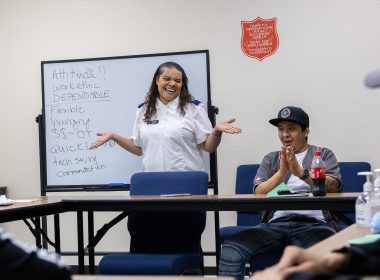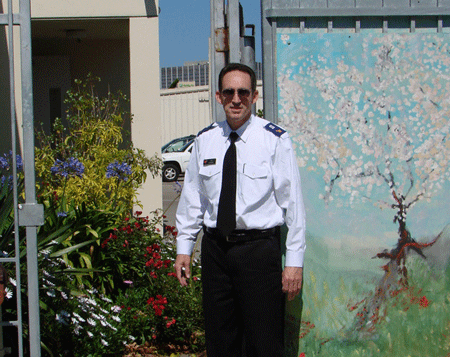1906 San Francisco Earthquake
by Judy Vaughn –
The Salvation Army provincial headquarters. |
The twentieth century was barely six years old when this headline ran in the The War Cry dated May 5, 1906:
“San Francisco in Ruins – Greatest Catastrophe of the Century”
“The bell tolls for doomed San Francisco! Earth’s forces have combined to wipe out a noble city from its face by means of Earthquake and Fire! Oh, the mutability – the transitoriness, the unimaginable littleness of things human when placed in contact with the mighty forces of Nature….
The April 18, 1906, quake lasted 46 seconds. Santa Rosa was devastated, including the Army’s corps building there and the orphanage at Lytton Springs—but like Hollister, Watsonville, and Santa Cruz in the Loma Prieta earthquake of 1989—everything that happened in those communities took a back seat to what was going on in the city by the Bay.
All eyes were on San Francisco.
City on fire
Suddenly, it was not only a city of shattered buildings; it was a city on fire. A city of wooden houses. Three days of fires followed the initial damage. A total of 490 city blocks were destroyed. In 96 hours, Southern Pacific train and ferry service reportedly carried away 225,000 refugees.
Salvation Army personnel in Oakland met hordes of refugees arriving from the city by ferry. They set up feeding stations downtown and turned Beulah Park into a tent city where refugees lived for weeks. Chinese Salvationists from San Francisco played a major role in feeding thousands. The tent city housed about 700 people, 159 of whom were children.
After the military took over some of the responsibility of running Beulah Park, Salvationists returned again to San Francisco to assist in recovery efforts.
All this information trickled back east. National Commander Evangeline Booth responded “like a cavalry horse to action” and kicked off a fundraiser in New York’s Union Square that ultimately raised $12,000. On Memorial Day of that year, she brought $15,000 to San Francisco and in a Golden Gate Park rally spoke to a mass meeting of refugees. It’s reported that she emptied the Army’s entire national reserves for relief efforts.
Do something!
Rallying the troops in New York, Booth did what she knew best—rousing the crowds with the famous words of her father William Booth: “Do something! Do the most you can—do it well—do it now.”
Mark Twain from the Waldorf Astoria in New York also helped raise funds. “The Salvation Army is the best means I know of to do this work. They are of the poor, and they know how to reach the poor. I have seen their work all over the world—always good.”
San Francisco’s awful need:
The way Sister Alice Sturdevant saw it
“From Mission Street to Bay, down Third, Fourth, Fifth, Sixth and Seventh to Nineteenth Street, there are nothing but squares of ashes not four feet high. The fire also burned clean up Clay, Washington, Sacramento, California and all those streets away out to the Presidio and all Chinatown and North Beach and Barbary Coast.
“Above the ashes, and dragging on the ground, are the wires; these point out where the streets have been.
“None were allowed in their houses and anyone starting a fire in a stove was shot by soldiers. Anyone rummaging anywhere was shot down. One man was caught disregarding the instructions and was shot and placarded as a warning to others.
“Corpses were left lying on Market Street after being shot.
”While we were camped on the hill, it was like one family—everyone divided up; even an orange was split as small as possible and the pieces given to the most needy and faint cases. Many were dazed and hardly comprehended it all. Anyone getting hysterical was called down quickly and shamed out of it.”
The denizens of South of Market
From the beginning of its San Francisco work in 1883, The Salvation Army had concentrated most of its energy in the South of Market. This neighborhood was devastated by the quake. Ramshackle wooden boarding houses sank into liquefied ground. Fire engulfed the area.
Author Charles Caldwell Dobie seemed stunned by the looks of those who ran from the far side of Market Street to the safety of Union Square.
“The Square was swarming with refugees from South of Market districts,” he said. “…Many of the wretches who had fled from the flames looked as if they had not faced the morning sunlight for years. They were like rats startled out of their holes, this beer-sodden, frowsy crew of dreadful men and still more dreadful women. A breed that has passed out of American life completely—red-faced, bloated, blowsy.”
These, of course, were the people The Salvation Army knew best.
Mechanics’ Pavilion
Denial of Disaster by Gladys Hansen and Fire Chief Emmet Condon (Ret.) gives a detailed account of relief services at Mechanics’ Pavilion. Along with other volunteers, Salvation Army soldiers scoured the neighborhood for supplies, even smashing drug store windows to find them.
Lucy Fisher from the American Journal of Nursing described a group of doctors and nurses tending to an “unconscious and mangled form of a woman.” She held the woman’s “poor crushed leg” as they bandaged it. At the time, the surgeon thought she would recover from having the leg amputated—but with fires threatening, she was moved twice. She later died from shock.
The woman was Adjutant Anna Alleman Butler. She was the only Salvationist to lose her life during the fire, buried at Laurel Hills Cemetery and later moved near the Army’s plot at Cypress Lawn.
Ham and Eggs Fire
The Pavilion—a wooden building—served as a makeshift hospital from 5:30 a.m. until 1 p.m. That’s when the infamous Hayes Valley fire sealed its fate. Historians and earthquake cognoscenti know the fire by its popular name—the “ham and eggs fire.” After all the excitement of the morning, a hungry San Franciscan decided to make breakfast, or maybe it was lunch, on a stove with an earthquake-damaged chimney. Enough said. A blaze broke out at 11:00 a.m. and spread uncontrollably. By the time it reached the roof of Mechanics’ Pavilion, there was no hope for the building.
Volunteers evacuated 354 patients. The Salvation Army moved many on its small fleet of Industrial Home wagons, horse-driven forerunners of today’s thrift store trucks.
Bodies of the dead were cremated in the ruins.
With plenty of pluck
Early day Army recruitment forms always made a point of looking for soldiers “with plenty of pluck.” How do you measure pluck? And what was it anyway? Commander Evangeline Booth commended at least one “plucky” little lassie following the quake:
”I talked with one little lieutenant who had been a heroine in the disaster,” she said. (This was undoubtedly Elsie Alleman, sister of Anna Alleman Butler described above). “(She) was the last to leave the Mechanics’ Pavilion on the block bounded by Hayes, Grove, Polk and Larkin…”
Elsie Alleman continued the work after her sister died. Colonel George French said that in one day alone she and Lieutenant Hynes, “situated at the General Hospital at the Presidio, served 1,500 gallons of milk in cupfuls, principally to mothers and children….”
“Where’s my Ma?”
Staff Captain William I. Day opened a department at Beulah Park for lost and strayed children and also lost friends, saying State authorities were expected to help.
“Many children got separated from their parents in the confusion of sending refugee trains to the North, South and East and consequently in Oregon, Southern California, Nevada, Utah and other points, babies and young children are found who cannot tell where they came from or who their parents are, or how they got lost. Some of the older ones are able to give particulars, but the authorities can only find the parents through the slow, uncertain means of the long lists in the newspapers….
“Parents come to our Salvation Army Camp at Beulah every day, inquiring for children who they have not seen for a week.
“The little girl you see over yonder with the dog is Alma Jacobson, one of six children of Mr. and Mrs. Rudolph Jacobson, Germans who kept a fruit store at 1944 Mason Street. The several moves rendered necessary by the encroaching fire brought the family to the beach.
“Little Alma’s dog ran away, and she ran after it. When she got back, her relatives were all gone.
“Captain Hynes took charge of her and she is now in the camp awaiting the newspaper lists of the lost to reunite her with her relatives.”
All but two Salvation Army buildings destroyed
The Salvation Army in San Francisco rebuilt quickly after the quake. Colonel George French’s annual report puts it into perspective:
“With the exception of The Salvation Army #4 Hall at 24th and Mission streets, and the dwelling house of the officers in charge of this corps, every Hall, Officer’s Quarters, Institution, Property and Headquarters in the entire city of San Francisco was, with the properties of others, wiped out of existence with a loss aggregating nearly $150,000, a large portion of it being assets of such a character as is impossible to cover by insurance.
“The reader will readily understand the disorganization of the first few days. Our officers and soldiers were scattered far and wide amongst refugees. Buildings destroyed, records partly burned, the rest unprocurable; funds tied up in City Banks. On the whole the outlook was indeed gloomy.
“While it is impossible to give figures, it is hard to overestimate the spiritual work accomplished by our lassie officers who lived for weeks in the relief camps, visiting the refugees, holding meetings and in many ways alleviating physical suffering. Captain Alleman and Lieut. B. Hynes did a specially helpful work at the Presidio General Hospital, being for several weeks the only religious workers allowed to visit the injured treated there.”
Booth said it best
Perhaps the words of Commander Booth in an early issue of The War Cry tell it best. Part description, part pep talk, her message was upbeat and positive.
“The natural hopefulness, I was going to say sunnyness of the Californian disposition, has stood them in good stead; all their troubles and privations have not been able to keep them under. They have spirits like corks and come up with a bounce every time.”








